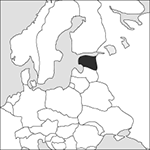
Source: MAPS IN MINUTES™ © RH Publications (1997)
Capital:
Tallinn
Area:
45,228 sq km (17,463 sq miles)
Population:
1,266,375 (2012 est)
Currency:
1 euro = 100 cents
Religions:
Eastern Orthodox 16.2%; Lutheran 9.9%; other Christian 2.2%
Ethnic Groups:
Estonian 68.7%; Russian 24.8%; Ukrainian 1.7%
Languages:
Estonian (official); Russian
International Organizations:
UN; OSCE; EU; NATO; Council of Europe; WTO; OECD
A country in the north of Europe, bounded on the north by the Gulf of Finland, on the east by Russia, on the south by Latvia, and on the west by the Baltic Sea.
Physical
Two large islands and numerous small ones lie off the coast, which is occasionally ice-bound in winter although the summers are warm. The mainland comprises a limestone plateau in the north, and a low-lying plain on which are situated forests and lakes of glacial origin.
Economy
Estonia has developed a successful market economy since the collapse of the Soviet Union. Its principal exports are machinery and electrical equipment, wood and wood products, metals, and furniture. It also has a significant information technology industry. The agricultural sector is small, its main products being grain, potatoes, and vegetables.
History
Annexed by Russia in 1709, Estonia regained its independence in 1918, at the time of the Bolshevik revolution. Its history during the 1920s was of an agrarian revolution, whereby the great estates of the Baltic barons (mostly German) were broken up, creating a prosperous peasantry. An attempted communist uprising in 1924 was suppressed. Its economy was adversely affected by the Great Depression and from 1934 until 1939 it experienced a highly autocratic regime led by Konstantin Paets. His attempt to make a pact with Hitler was invalidated by the Nazi-Soviet Pact of August 1939. In September Soviet troops occupied key ports and in 1940 the whole country. It welcomed German troops in 1941, but its anti-Bolshevik Resistance forces could not prevent the Red Army from reoccupying it in 1944. It became a constituent republic of the Soviet Union. In February 1990 there were mass rallies in the capital Tallinn demanding independence, and in May its Supreme Soviet reinstated the constitution of 1920. Talks began with the Soviet Union, which recognized the Republic’s independence in September 1991. The collapse of its markets in Russia during 1991 resulted in an economic crisis, with food and fuel rationing in January 1992, eased by trade agreements with the European Community and by IMF support. In 1992 a new constitution was adopted and Lennart Meri (1929–2006) was elected President. Russian residents were disturbed by a proposed law that would have denied them Estonian citizenship. The law was amended (1993) before it was passed, making citizenship available to residents who passed Estonian language tests. Two mainly Russian cities voted for autonomy (1993) but the government declared their referendums illegal. In 1994 the last Russian troops withdrew from Estonia. Estonia joined NATO and the European Union in 2004; it adopted the euro as its currency in 2011.
In 2014 border tensions with Russia increased after Russia’s takeover of Crimea, and security concerns formed a major part of the election campaign in 2015. The Reform Party gained the largest number of seats, ahead of the pro-Russian Centre Party, and Taavi Roivas, of the Reform Party, became Prime Minister, leading a coalition. His government fell in 2016, and was replaced by a Centre Party-led coalition.
- Corn Laws
- CORN rule
- Cornwallis, Charles, 1st Marquis (1738–1805)
- corolla
- corollary
- corona
- Corona Australis
- Corona Borealis
- coronagraph
- coronal bright point
- coronal condensation
- coronal hole
- coronal lines
- coronal loop
- coronal mass ejection
- coronal plume
- coronal rain
- coronary vessels
- Coronas
- obsolescence
- obsolete tag
- obtuse angle
- obverse
- OCAS
- occam